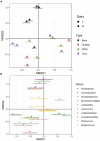The microbiota of Mozzarella di Bufala Campana PDO cheese: a study across the manufacturing process
- PMID: 37649628
- PMCID: PMC10462780
- DOI: 10.3389/fmicb.2023.1196879
The microbiota of Mozzarella di Bufala Campana PDO cheese: a study across the manufacturing process
Abstract
Introduction: Mozzarella di Bufala Campana PDO cheese (MBC) is a globally esteemed Italian cheese. The traditional cheesemaking process of MBC relies on natural whey starter culture, water buffalo's milk, and the local agroecosystem.
Methods: In this study, the microbial ecology of intermediate samples of MBC production, coming from two dairies with slightly different cheesemaking technology (dairy M large producer, and dairy C medium-small), was investigated using 16S rRNA amplicon sequencing. This research aimed to provide insights into the dynamics of microbial consortia involved in various cheesemaking steps.
Results and discussion: All samples, except for raw buffalo milk, exhibited a core microbiome predominantly composed of Streptococcus spp. and Lactobacillus spp., albeit with different ratios between the two genera across the two MBC producers. Notably, the microbiota of the brine from both dairies, analyzed using 16S amplicon sequencing for the first time, was dominated by the Lactobacillus and Streptococcus genera, while only dairy C showed the presence of minor genera such as Pediococcus and Lentilactobacillus. Intriguingly, the final mozzarella samples from both producers displayed an inversion in the dominance of Lactobacillus spp. over Streptococcus spp. in the microbiota compared to curd samples, possibly attributable to the alleviation of thermal stress following the curd stretching step. In conclusion, the different samples from the two production facilities did not exhibit significant differences in terms of the species involved in MBC cheesemaking. This finding confirms that the key role in the MBC cheesemaking process lies with a small-sized microbiome primarily composed of Streptococcus and Lactobacillus spp.
Keywords: 16S rRNA amplicon sequencing; Lactobacillus spp.; Mozzarella di Bufala Campana PDO; Streptococcus spp.; fermented food; lactic acid bacteria; microbial community; natural whey starter.
Copyright © 2023 Levante, Bertani, Marrella, Mucchetti, Bernini, Lazzi and Neviani.
Conflict of interest statement
The authors declare that the research was conducted in the absence of any commercial or financial relationships that could be construed as a potential conflict of interest. The reviewer GT declared a past co-authorship with the author AL to the handling Editor.
Figures





Similar articles
-
Isotopic and elemental profiles of Mediterranean buffalo milk and cheese and authentication of Mozzarella di Bufala Campana PDO: An initial exploratory study.Food Chem. 2019 Jul 1;285:316-323. doi: 10.1016/j.foodchem.2019.01.160. Epub 2019 Jan 30. Food Chem. 2019. PMID: 30797351
-
A Preliminary Study on Metabolome Profiles of Buffalo Milk and Corresponding Mozzarella Cheese: Safeguarding the Authenticity and Traceability of Protected Status Buffalo Dairy Products.Molecules. 2020 Jan 12;25(2):304. doi: 10.3390/molecules25020304. Molecules. 2020. PMID: 31940896 Free PMC article.
-
Antibiotic resistance and microbial composition along the manufacturing process of Mozzarella di Bufala Campana.Int J Food Microbiol. 2008 Dec 10;128(2):378-84. doi: 10.1016/j.ijfoodmicro.2008.09.021. Epub 2008 Oct 8. Int J Food Microbiol. 2008. PMID: 18990462
-
The Microfloras and Sensory Profiles of Selected Protected Designation of Origin Italian Cheeses.Microbiol Spectr. 2014 Feb;2(1):CM-0007-2012. doi: 10.1128/microbiolspec.CM-0007-2012. Microbiol Spectr. 2014. PMID: 26082116 Review.
-
Milk microbiota: Characterization methods and role in cheese production.J Proteomics. 2020 Jan 6;210:103534. doi: 10.1016/j.jprot.2019.103534. Epub 2019 Oct 16. J Proteomics. 2020. PMID: 31629058 Review.
Cited by
-
Explainable artificial intelligence and microbiome data for food geographical origin: the Mozzarella di Bufala Campana PDO Case of Study.Front Microbiol. 2024 Jun 3;15:1393243. doi: 10.3389/fmicb.2024.1393243. eCollection 2024. Front Microbiol. 2024. PMID: 38887708 Free PMC article.
-
Shotgun metagenomic sequencing reveals the influence of artisanal dairy environments on the microbiomes, quality, and safety of Idiazabal, a raw ewe milk PDO cheese.Microbiome. 2024 Dec 20;12(1):262. doi: 10.1186/s40168-024-01980-0. Microbiome. 2024. PMID: 39707557 Free PMC article.
-
Brucellosis in cattle and buffalo in southern Italian provinces: trends in presence of territory-specific One Health measures.Front Microbiol. 2025 Jun 6;16:1609336. doi: 10.3389/fmicb.2025.1609336. eCollection 2025. Front Microbiol. 2025. PMID: 40547795 Free PMC article.
-
Structural and Physico-Chemical Changes of Mozzarella di Bufala Campana Cheese Influenced by Covering Liquid Composition.Foods. 2025 Apr 25;14(9):1506. doi: 10.3390/foods14091506. Foods. 2025. PMID: 40361589 Free PMC article.
-
Utility of dairy microbiome as a tool for authentication and traceability.Open Life Sci. 2024 Oct 30;19(1):20220983. doi: 10.1515/biol-2022-0983. eCollection 2024. Open Life Sci. 2024. PMID: 39479351 Free PMC article. Review.
References
-
- Bertani G., Levante A., Lazzi C., Bottari B., Gatti M., Neviani E., et al. (2020). Dynamics of a natural bacterial community under technological and environmental pressures: the case of natural whey starter for Parmigiano Reggiano cheese. Food Res Int. 129, 108860. 10.1016/j.foodres.2019.108860 - DOI - PubMed
LinkOut - more resources
Full Text Sources
Miscellaneous

